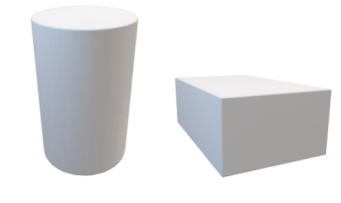General Information
Benchmark Instructional Guide
Connecting Benchmarks/Horizontal Alignment
Terms from the K-12 Glossary
- Circle
- Cone
- Cylinder
- Prism
- Pyramid
- Rectangle
- Square
- Triangle
Vertical Alignment
Previous Benchmarks
Next Benchmarks
Purpose and Instructional Strategies
In the elementary grades, students classified two- and three-dimensional figures. In middle grades, students worked with nets of three-dimensional figures when determining surface area. In Geometry, students begin to understand the concept of the two-dimensional cross-sections of familiar three-dimensional figures in preparation to discuss the formulas for the volume of these figures. In later courses, students will relate cross-sections to conic sections and will use cross-sections as a basis for finding the volumes of other three-dimensional figures.- For the purposes of this benchmark, there is no expectation for students to master cross-sections of non-right, or oblique, three-dimensional figures. Instruction can include these as an enrichment or as comparison to cross-sections of right figures. As an additional enrichment, composite figures can also be utilized within instruction.
- Instruction includes the student understanding that among the shapes of the two-dimensional cross-sections can be circles, rectangles, squares, triangles, trapezoids and all other polygons that can be used as the base of right prisms and right pyramids (when the plane is parallel or perpendicular to the bases).
- When the vertical cross-section of a right cone does not include the apex, it is one piece of a hyperbola. Since many students at this level are not familiar with hyperbolas, the expectation is not to name the hyperbola, but be able to draw or visualize this cross-section. For enrichment, instruction may include showing that it is not a parabola, since it has diagonal asymptotes.
- Instruction focuses on pyramids with bases that are either equilateral triangles or squares, with the vertical cross-sections being parallel to a side of the base so that the vertical cross-sections are isosceles triangles and isosceles trapezoids. Since vertical cross-sections of pyramids include triangles that are not isosceles, and a variety of irregular polygons it may be difficult for students to visualize or name.
- Instruction includes utilizing objects, such as soda cans, cereal boxes or party hats, as models to explore their cross-sections. Additionally, students can explore other cross-sections using manipulatives such as clay and string to cut through the three-dimensional figure. (MTR.7.1)
Common Misconceptions or Errors
- Students may oversimplify when they try to visualize cross-sections. To help address this misconception, use real-world three-dimensional figures to explore their cross-sections, as well as animations.
- Students may have difficulty with vertical cross-sections of pyramids and cones. To help address this, utilize manipulatives and physical models within instruction.
Instructional Tasks
Instructional Task 1 (MTR.3.1, MTR.4.1)- Part A. Draw and name right three-dimensional figures that could have a triangular cross-section.
- Part B. Draw and name right three-dimensional figures that could have a circular cross-section.
- Part C. Compare your answers from Parts A and B with a partner.
- Part A. Fill in the blank below. Both a right cylinder and a right prism have _______ cross-sections when cut perpendicular to the base.
- Part B. Draw some cross-sections that are perpendicular to the base for each figure below.

Instructional Items
Instructional Item 1- Which of the following polygons are cross-sections that are parallel or perpendicular to the
base of a regular pentagonal pyramid? Select all that apply.
- a. Triangle
- b. Parallelogram
- c. Trapezoid
- d. Pentagon
- e. Hexagon
- f. Octagon
